20 July-6 Aug 2013. A continuation of the story of Oaxaca’s Guelaguetza Festival:
ESPECTÁCULO MASIVO! That’s what the program said. Delegaciones Danza de la Pluma – 60 danzantes! Delegaciones de Chinas Oaxaqueñas – 100 Canasteras! Delegaciones de Flor de Piña – 100 Bailarinas! It was one of many free dance performances. Ten days of dancing and we actually paid an entrance fee for only four of them. The whole town was buzzing with daily free dance and music performances, a food festival and a mescal festival.
There’s a large square next to a church in the central part of Oaxaca called Plaza de la Danza and it is there that we saw this espectáculo performance of the dancers from Chinas Oaxaqueñas in the central valley, with their bright skirts and colourful baskets on their heads. A canastera is a basket maker and the dancers would have all come from the villages where basket making was the major occupation. One hundred of them. Dancers, not villages.
Before the performance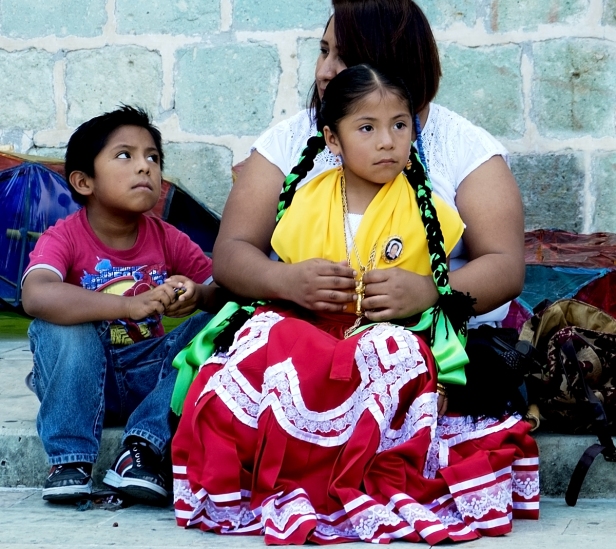

Many of the dance groups included quite young children, who had no trouble keeping up.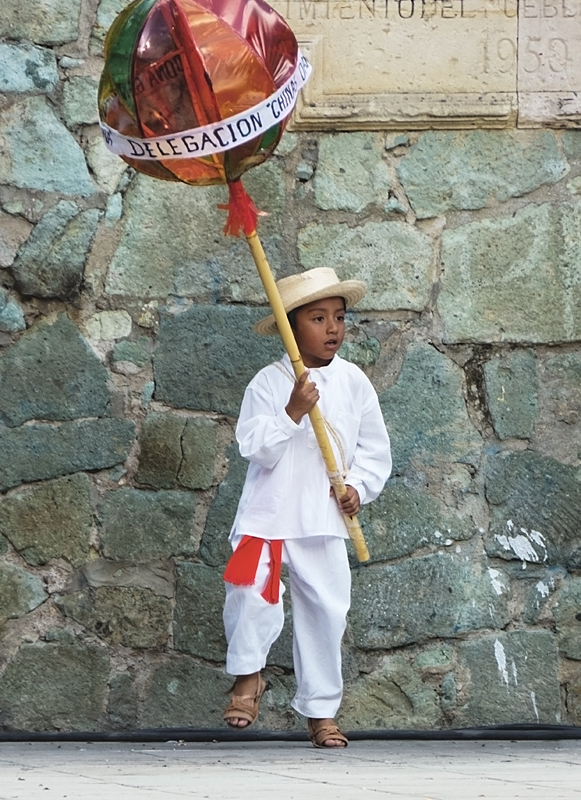
The dance of Chinas Oaxaqueñas


The pineapple dance, or Flor de Piña is a Tuxtepec dance from the Papaloapan region. I think. Information is sketchy, sometimes contradictory, and often in Spanish. What I do know is the pineapple dance is definitely espectàculo! Imagine one hundred dancers in a line coming at you at a fast trot, then weaving in and out, waving their pineapples in the air, and at the end of the dance hurling the pineapples into the crowd! I’m not joking. Guelaguetza is about mutual gifting. The word itself means the mutual sharing of gifts, or mutual helping. Every group hurls gifts into the audience at the end of their performance. The pineapple dancers are no exception. When we first got to Oaxaca we couldn’t buy a pineapple for love nor money. We soon found out why. We also soon got a couple of pineapples.

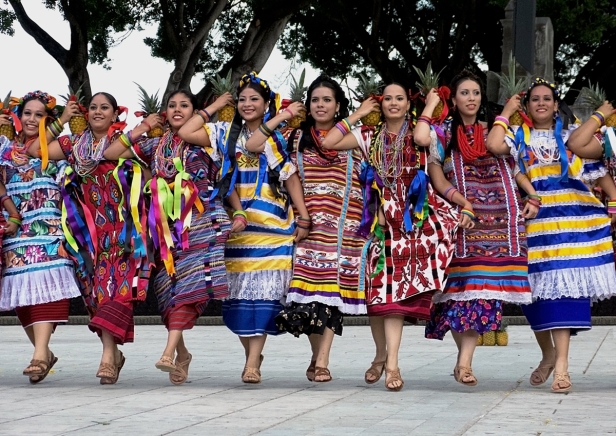
Truly espectàculo was the performance of not one or two, but six Danza de la Pluma groups with nine dancers in each group, a couple of Major Domos to keep them all in line, and two young girls, one representing the indigenous people and one representing the Spanish conquistadors. At the performance we saw at the stadium there was also a large group of dancers representing the conquistadors. There are photos of them in the previous post.
The Danza de la Pluma is a ritual enactment of the battles between the indigenous people and the Spanish conquerors, originating in Cuilapan de Guerrero. It is a great honour to be chosen to dance, and if chosen there is a commitment to dance for three years. Some are chosen in childhood and learn the steps from a very young age.
Before the performance:

and during.

The performance at the stadium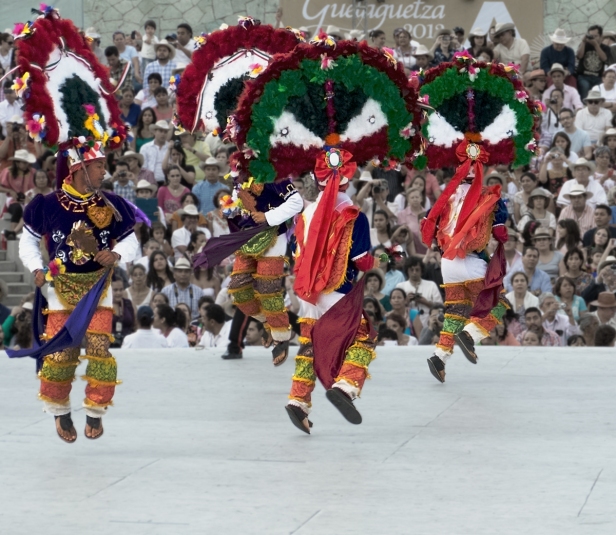
and Don’s photo at the Plaza de la Danza
We went to see Centeotl, a contemporary stage production presented by the Oaxaca Traditional Folk Dance Company. According to the program it was:
a work that tells of the mythic origins of the Aztec culture and the worship of their gods, among them the goddess and protector of corn, Centeotl, who has become the connection point between the ancient rituals of Mexico and . . . . . the modern practices brought by the Spanish. Contact with western culture during the conquest transformed these early practices into Catholic celebrations. It was yet another espectáculo masivo!
Resplandor Del Istmo was magnificently resplendent. An evening performance of mime, poetry, story-telling and dance in a darkened theatre by the people of the Istmo (or isthmus) region of Oaxaca. Best costumes ever! Truly glorious. These are the fashions after which Frida Khalo styled her dress. It didn’t matter to me that I couldn’t understand the Spanish announcements or narrator, or that the dances were slow. I was too busy photographing, and inhaling the beauty of the costumes. Don was less entranced and called the dances glacial. One of the dances is actually called La Tortuga, meaning the tortoise. Not a name to conjure images of a whirling dervish. But he did love the beauty of their sumptuous outfits. We saw the Istmo dancers at Santa Maria Del Tule, at Resplandor Del Istmo, in the parade, and again at the stadium. The photographs are chosen from all four locations.




I hope you’re not all getting sick of the onslaught of the dancers and dances and fabulous costumes of the indigenous people of Oaxaca. This is the third post, and one more to come. Perhaps I’m overdoing it, but it was such an amazing experience, so rich in colour and movement and music and joy that I want to share everything! So next post – more of Guelaguetza. Viva Guelaguetza!
All words and images by Alison Louise Armstrong unless otherwise noted.
© Alison Louise Armstrong and Adventures in Wonderland – a pilgrimage of the heart, 2010-2015.

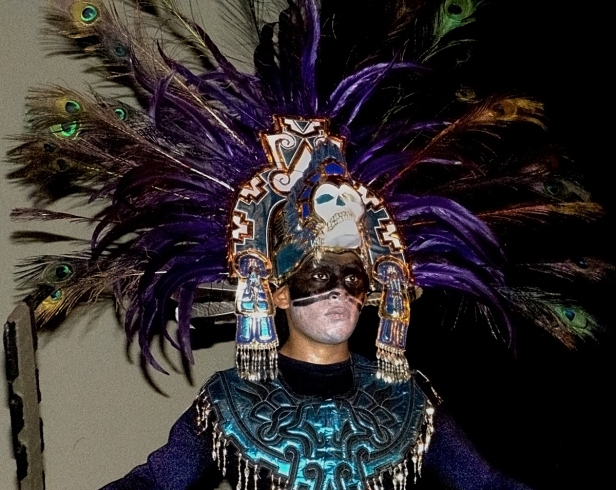
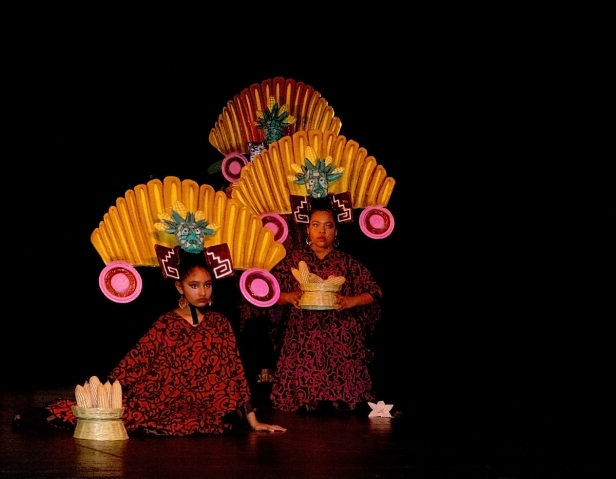


So beautiful! Kudos~
LikeLiked by 1 person
Thanks Cindy. Beautiful subject – everywhere we looked, beauty and more beauty.
LikeLike
Y Que Viva Mexico!
Spectacular photos! I just love all the costumes and color.
LikeLike
Thanks Angeline. Yes! Viva Mexico!
We have a whole different perception of Mexico now that we have spent some time there.
LikeLike
The unbridled joy that you’ve captured in these vivid photographs is spectacular!
LikeLike
Thanks Laurie. I’m glad I managed to capture how it was. It was such a joyous time for everyone.
LikeLike
wowzers!
The color! The energy!
Just…. wowzers!
LikeLike
Yes! That’s exactly what we thought at the time! Every day – wowzers!
LikeLike
The colors are incredible, as I can only imagine the dances are. Watch out for flying pineapples however. Some of those puppies are heavy… not to mention scratchy. (grin) –Curt
LikeLike
Yes, it was all pretty incredible. Especially those flying pineapples 🙂
LikeLike
Wow! This is an amazing post, Alison & Don. Guess we are just going to have to stay and go to this festival…can’t imagine anyone missing it!
LikeLike
Thanks Pam. Yes, the festival was extraordinary, and definitely worth going to. And there is so much more going on than the dancing. In order to not be overwhelmed we focused on that. I do wish I’d just stuck my head into the mescal festival area, and the mole festival if only for the photo ops. Also 6 or 8 of the nearby villages have their own mini festivals, plus there’s free music on every night. And more than one free afternoon dance performance going on at the same time on some days. Because of not being able to read Spanish well enough, and not fully understanding at times if it was referring to dances or regions or towns or ethnic heritage we missed some groups and saw others more than once. No matter.
When we looked online the only dates given were the Mondays 22 and 29 which only refer to the big performances at the stadium. We arrived at night on the 20 – there had been a big parade (probably of different groups than we saw in the parade the following week) that day which we missed, and also the competition for the “Corn goddess” had taken place in the few days before. So….go early, be prepared for long days, book your seats (ticketmaster) for the stadium performance early for the best seats (about a month ahead) and get a centrally located hotel/apartment. It will be so worth it. As you say – not to be missed. May/June in La Manz much like April. July getting very hot and steamy and the roads fall apart as I’m sure you know. You’ll definitely be ready to go to Oaxaca by mid July.
Hugs from us
Alison
LikeLike
That must have been a very amazing vibrant ten days of dancing. How festive! xoxox Paulette
LikeLike
Yes, very festive! 🙂
It certainly was an amazing vibrant time. We were so lucky to have been there.
xoxox
LikeLike
the vibrant colours mixing with the beautiful smiles… priceless. I am in awe and envy… wow..
LikeLike
Oh yes it was a priceless experience. We were so lucky to be able to go to it. We were in awe too, by all aspects of it – the organization, the joy, the colour, the dedication to their dances and music, their pride in their culture. Truly heartwarming.
LikeLike
STUNNING photos. You take us there. The women are beautiful, esp the one with the pineapple. Not only her colors, but the health and joy she radiates. What an adventure!
LikeLike
Thank you so much. I’m glad I can convey something of how it was. Yes, a very wonderful adventure. So lucky to have been there.
I also love that pineapple lady – many were like that. The dancers are committed and dedicated, and understand it is more than just dancing, and that, in and of itself brings joy and radiance.
LikeLike
i can truly see the vibrancy and richness of this diverse culture coming through your photographs. simply beautiful. thank you for this lovely moment. ♥
LikeLike
Thank you so much. I’m glad you enjoyed it. It’s such a rich culture, and such a joyous and deeply felt festival for these people that I’m glad I can convey something of how it is.
LikeLike
Love love love all the spectacular photography. My favorite from this batch is Don’s photo of the dancers in the square.
Also, if the festival is about mutual gift-giving, did you throw anything back to the pineapple dancers?
LikeLike
Thanks Felicity. Don was thrilled that his photo is your favourite, and I must say I agree it is a spectacular photo.
No the audience didn’t throw anything back for the dancers at any of the sessions, however in the communities there is very much a tradition of sharing and mutual gifting.
LikeLike
Don’s photo of the leaping dancers is truly wonderful. Don’t worry about going on about this event…loving all these photos and looking forward to more!!
LikeLike
Thanks Fiona. Good to hear you’re looking forward to more – one last post about two grand performances at the stadium. Ten thousand people cheering! Fun.
Don took a good one eh?
LikeLike
Wow! Amazingly beautiful! And your photos capture it wonderfully. Great Post!
LikeLike
Thanks Margo. I’m glad you enjoyed it. I’ve been looking at your website – makes me ache for France. I can’t believe I didn’t go there and thank you for following – or maybe I did and can’t find it now. Anyway thank you for following! I hope you enjoy the stories of our journey.
Cheers
Alison
LikeLike
What incredible color, Alison! Your photos are gorgeous. I can only imagine the handwork that goes into many of those outfits. Makes my fingers tired just thinking about it. 🙂 ~Terri
LikeLike
Thanks Terri. I too was impressed with the work involved to make the costumes, all so intricate and beautiful.
LikeLike
Wow, you really travelled during some very good periods with beautiful festivals!
LikeLike
Yes, we were very lucky with our timing in Mexico. Guelaguetza was just fabulous!
LikeLike
Those are some SPECTACULAR photos. It looks like you had front row seats for that. You did an awesome job of capturing the color and the energy of the dancers.
We are going out of our way to be in Oaxaca for the Day of the Dead festivals because I heard they are some of the best in Mexico. Did you like Oaxaca in general?
LikeLiked by 1 person
Thanks Jeff. We had front row seats for the performances in the Plaza de la Danza, but were back a little bit at the stadium. We were in the street at the beginning of the parade so were standing right next to the dancers. We loved Oaxaca, both the city and the province, and if Guelaguetza is any indication the Day of the Dead should be another espectáculo masivo!
LikeLiked by 1 person
I really enjoyed this post – I was led to it in readings of Gallivance. We live in Oaxaca half of the year, and our apartment is right around the corner from the Plaza de la Danza. We have never been here during the Guelaguetza festivities, and your gorgeous photos show us what we have to look forward to! Thanks, and I’m going to look at your other Mexican posts. It’s great to see familiar things through another person’t eyes, and to see things we should be looking out for!
LikeLiked by 1 person
Hi Marylin, nice to meet you. I’d imagine half a year in Oaxaca is quite wonderful. We love Mexico. We’re currently in SMA for 3 months then on April 4 we go to the beach at La Manzanilla for 2 months. I’m assuming you’ve found the other Guelaguetza posts. It was one of the highlights of our travels.
Cheers, Alison
LikeLike
That embroidery!!! Looks like some of the best I’ve seen in the world!
LikeLiked by 1 person
It absolutely is. I was totally blown away by the costumes at both Guelaguetza and Candelaria. Scroll towards the end of this post about Candelaria – there’s a pic of the rear view of 3 yellow capes – the embroidery is absolutely amazing. https://alisonanddon.com/2014/06/13/a-party-of-epic-proportions-the-festival-of-the-virgin-of-candelaria/
But you’ll also see the incredibly high standard of almost all the costumes.As the daughter of a highly skilled dress-designer, seamstress, and costumer I of course was as much enthralled by the costumes as I was by the dancing.
Alison
LikeLike